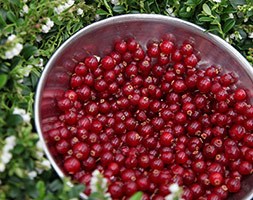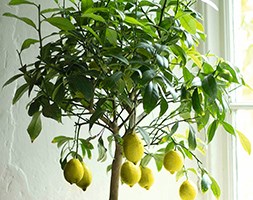Price reductions at Crocus
by Sarah - November 26th, 2014.Filed under: Crocus, Price Reductions.
Crocus has cut the price of these products
Vaccinium vitis-idaea ‘Red Candy (PBR)’ (cowberry) was £6.99 now £4.99
One of the photos on this page shows the plant with gift wrap. This is not included in the price, however you may add gift wrap (for an additional charge of £4.95) during the order process. Position: full sun Soil: prefers moist, but freely draining acidic soil but will grow in sandy or normal soil Rate of growth: fast-growing Other features: edible but acidic red berries Hardiness: fully hardy Clusters of pink-flushed white flowers are followed by shiny red berries from mid- to late summer. These berries have a tart flavour, but can be harvested and eaten straight away (if you have a sweet tooth try crushing them up with a bit of sugar), or cooked and sweetened to make jam or compote. They appear on a low-growing, evergreen shrub, which will slowly spread to form a generous, leafy clump. Originating from the Arctic and alpine regions of Northern Europe and North America, this plant is incredibly tough and robust. Garden care: Prepare the ground well before planting by digging in lots of composted organic matter. Prune in winter, cutting out dead or damaged branches. In spring, feed with sulphate of ammonia, sulphate of potash and bonemeal and top-dress with ericaceous compost.
Camellia japonica ‘Matterhorn’ (camellia) was £29.99 now £19.99
Position: partial shade (but not east-facing) Soil: moist but well-drained, humus-rich, acid soil (or ericaceous compost for container-grown specimens) Rate of growth: average Flowering period: March to April Hardiness: fully hardy Magnificent formal double white flowers weight the gently arching branches down when they appear in spring. The lustrous green leaves of this shrub are held throughout the year, so they will provide interest throughout the year. It is when the flowers appear though, that it really stands out. Use it to light up partially shaded border and if there is room, underplant with spring flowering bulbs for a double display. Garden care: To prevent damage to the emerging buds and flowers protect from cold, dry winds and early morning sun. Water established plants in dry weather to prevent bud drop. Apply a balanced liquid fertiliser in mid-spring and again in June. Top-dress annually with shredded bark or well-rotted leaf mould. After flowering lightly trim or prune any branches that spoil the appearance of the plant.
Lemon ‘Four Seasons’ (lemon) was £39.99 now £24.99
Position: a sunny patio outside, or bright conservatory in winter Soil: moist but well-drained soil. John Innes No2 compost should be used when potting up Rate of growth: average Flowering period: April to September Other features: exceptionally flavoured lemons and deliciously scented flowers. Hardiness: tender (needs winter protection) A remarkable, heavy-cropping, little tree with glossy, dark green leaves and smooth-skinned, bright golden fruit with exceptional flavour. This clever variety is unique in that it keeps on producing flowers from spring to autumn, so it is possible to have flowers, small, un-ripened fruit as well as ready-to -pick lemons on the plant at the same time. One of the hardiest lemon trees available, it can be grown on a sunny patio in summer, but will need an unheated conservatory or greenhouse to over-winter. The plants may not arrive with fully developed lemons, but they are top-notch, quality plants. Garden care: Ideally grow in a pot which is easily moved from terrace to conservatory, in soil-based compost. Feed every two weeks with a special citrus fertiliser (there is one for summer and another for winter), and pot on or top-dress plants in late winter. Move outside after the risk of frost has passed to a sunny, sheltered patio.









